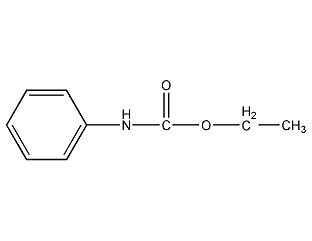
Structural formula
| Business number | 02LG |
|---|---|
| Molecular formula | C9H11NO2 |
| Molecular weight | 165.19 |
| label |
phenylurethane, phenylurethane, phenylurethane, N-diphenylurethane, Ethyl aniline, phenylurethane, Ethyl Carbanilate, Ethyl N-Phenylcarbamate, N-Phenylcarbamic Acid Ethyl Ester, Phenylurethane |
Numbering system
CAS number:101-99-5
MDL number:MFCD00026806
EINECS number:202-995-9
RTECS number:FD8925000
BRN number:1942785
PubChem ID:None
Physical property data
1. Properties: white crystalline powder.
2. Density (g/mL, 25℃): 1,106
3. Relative vapor density (g/mL, air=1): Undetermined
4. Melting point (ºC): 47-51
5. Boiling point (ºC, normal pressure): 237
6. Boiling point (ºC, 2mmHg): Undetermined
7. Refractive index: 1.5375
8. Flash point (ºC): 237
9. Specific rotation (º): Undetermined
10. Autoignition point or ignition temperature (ºC): Not determined
11. Vapor pressure (mmHg, 20ºC): Not determined
12. Saturated vapor pressure (kPa, ºC ): Undetermined
13. Heat of combustion (KJ/mol): Undetermined
14. Critical temperature (ºC): Undetermined
15. Critical Pressure (KPa): Undetermined
16. Log value of oil-water (octanol/water) distribution coefficient: Undetermined
17. Explosion upper limit (%, V/V): Undetermined
18. Lower explosion limit (%, V/V): Undetermined
19. Solubility: Undetermined
Toxicological data
1. Acute toxicity: unknown LDLo in rats: 500mg/kg; LD50 in peritoneal cavity in mice: 350mg/kg; LDLo in mice subcutaneously: 1mg/kg; LD50 in intravenous injection in mice: 400mg/kg; 2. Chronic toxicity/carcinogenesis Safety: Mouse skin contact TDLo: 20mg/kg/2W-I; Mouse skin contact TDLo: 72mg/kg/15W-I;
Ecological Mathematics��
Generally speaking, it is not harmful to water.
Molecular structure data
1. Molar refractive index: 46.90
2. Molar volume (cm3/mol): 145.3
3. Isotonic specific volume (90.2K ): 370.4
4. Surface tension (dyne/cm): 42.1
5. Dielectric constant:
6. Dipole moment (10-24cm3):
7. Polarizability: 18.59
Compute chemical data
1. Reference value for hydrophobic parameter calculation (XlogP): None
2. Number of hydrogen bond donors: 1
3. Number of hydrogen bond acceptors: 2
4. Number of rotatable chemical bonds: 3
5. Number of tautomers: 2
6. Topological molecule polar surface area 38.3
7. Number of heavy atoms: 12
8. Surface charge: 0
9. Complexity: 142
10. Number of isotope atoms: 0
11. Determine the number of atomic stereocenters: 0
12. Uncertain number of atomic stereocenters: 0
13. Determine the number of chemical bond stereocenters: 0
14. Number of uncertain chemical bond stereocenters: 0
15. Number of covalent bond units: 1
Properties and stability
Avoid contact with strong oxidizing agents.
Storage method
Store in a cool, ventilated warehouse. Keep away from fire and heat sources. should be kept away from oxidizer, do not store together. Equipped with the appropriate variety and quantity of fire equipment. Suitable materials should be available in the storage area to contain spills.
Synthesis method
None yet
Purpose
None yet


